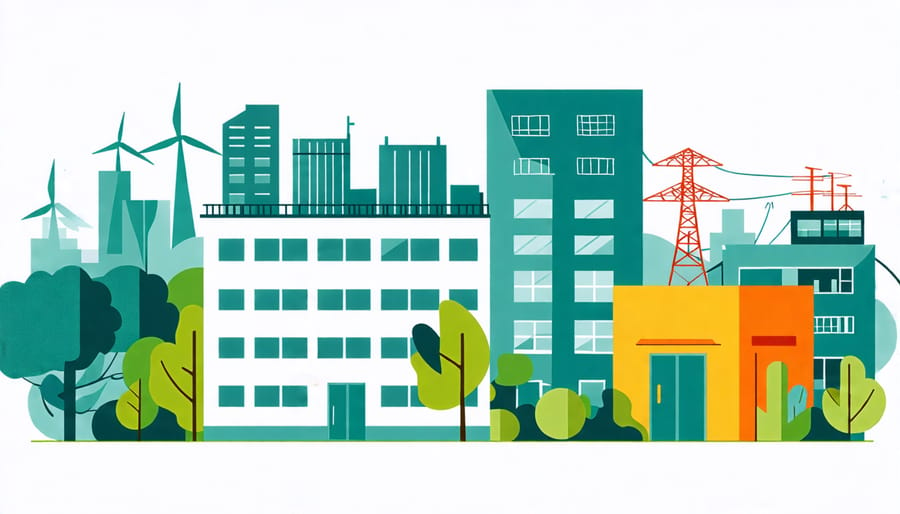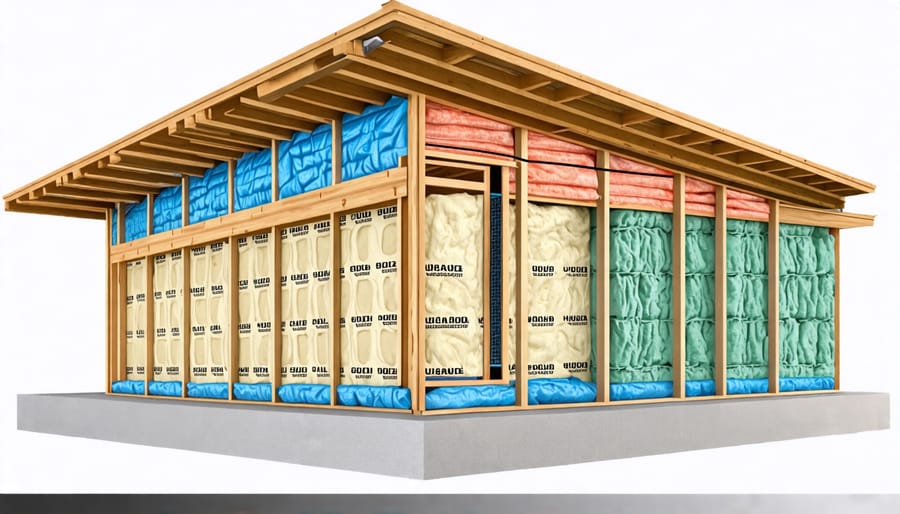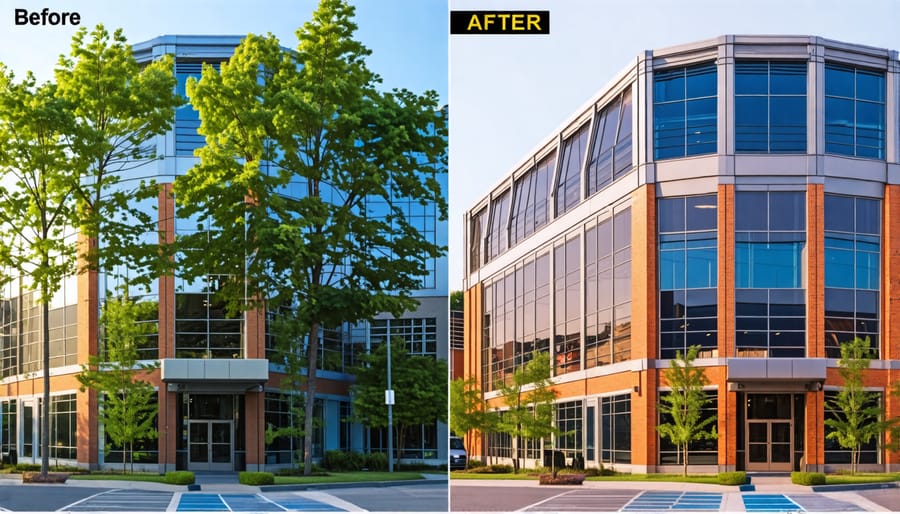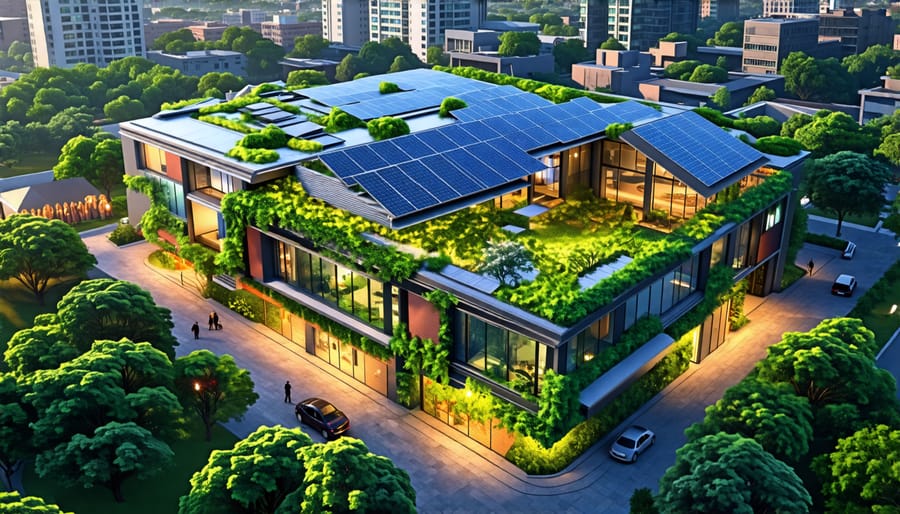Upgrade building insulation to minimize heat loss and boost energy savings. Install high-efficiency HVAC systems and smart thermostats to precisely manage energy consumption. Implement LED lighting and automated controls for significant reductions in electricity usage. Integrate renewable energy sources, such as solar panels, to further enhance sustainability and reduce reliance on conventional power.
The Importance of Energy Efficiency in Buildings
Environmental Benefits
Energy-efficient retrofits are a powerful tool in the quest for reducing building emissions and minimizing environmental impact. By upgrading existing structures with improved insulation, high-performance windows, and efficient HVAC systems, retrofitting significantly cuts energy consumption, thus lowering carbon footprints. These enhancements not only bolster a building’s thermal performance but also lead to a reduction in the reliance on fossil fuels, thereby contributing to a decrease in greenhouse gas emissions. Implementing energy-efficient retrofits is a strategic approach favored by construction professionals seeking sustainable solutions. Such retrofits can extend the lifespan of infrastructure while aligning with global environmental goals. The cumulative effect of these upgrades is profound; retrofitted buildings enjoy enhanced energy performance that translates into reduced operational costs and a healthier environment. By integrating modern energy solutions into existing frameworks, decision-makers and architects can play a pivotal role in promoting sustainable urban development that meets both economic and ecological criteria.

Economic Advantages
Energy-efficient retrofits offer substantial economic advantages for construction professionals and industry decision-makers. By enhancing the energy performance of existing structures, retrofits significantly reduce operational costs. Lower energy consumption directly translates into lower utility bills, providing an attractive return on investment over time. For instance, upgrading insulation, installing energy-efficient HVAC systems, and implementing LED lighting can collectively reduce a building’s energy expenditures by up to 30%, offering notable savings.
Moreover, numerous financial incentives and rebates are available to offset initial retrofit costs. Governments and local municipalities often provide tax credits and grants to promote energy efficiency, while utility companies may offer additional rebates for specific upgrades. These incentives can reduce upfront expenditure by a considerable margin, thus encouraging broader adoption of retrofit projects.
By investing in energy-efficient retrofits, stakeholders not only benefit from immediate cost reductions but also enhance the long-term valuation and marketability of their properties, ensuring economic viability and sustainability.
Key Retrofit Strategies
Insulation Improvements
Insulation plays a pivotal role in enhancing the energy efficiency of existing structures. By reducing heat transfer, effective insulation minimizes energy consumption and optimizes climate control, leading to substantial cost savings and environmental benefits. The first step in improving insulation is to conduct a thorough assessment of the building’s current insulation performance. This involves utilizing thermal imaging cameras to identify areas of heat loss, as well as conducting blower door tests to measure air infiltration.
Once problem areas are identified, upgrading to high-performance insulation materials such as spray foam, rigid foam boards, or blown-in cellulose can significantly enhance thermal resistance, often measured by their R-value. Sealing air leaks around windows, doors, and ductwork is equally crucial to boost overall insulation performance. Another approach involves adding weather stripping and caulking, which not only improves insulation but also addresses moisture control issues.
Incorporating radiant barriers in attics and reflective coatings on roofs can further contribute to maintaining desirable indoor temperatures. Implementing these strategies not only advances energy efficiency but also enhances building sustainability. For industry professionals, integrating these upgrades into retrofitting projects can yield significant improvements in energy performance, aligning with both economic and environmental objectives.

Upgrading HVAC Systems
Upgrading HVAC systems represents a foundational step in achieving energy-efficient retrofits for existing structures. Modern HVAC solutions are revolutionizing the way we manage energy consumption, integrating technologies like variable refrigerant flow systems and energy recovery ventilators to optimize efficiency. These systems adjust their output based on real-time demand, significantly reducing both energy waste and operational costs. The implementation of smart thermostats, equipped with IoT connectivity, further enhances control, allowing for precise climate management and remote monitoring capabilities.
Investing in high-efficiency HVAC systems also contributes to enhanced indoor air quality, aligning with evolving building standards and occupant expectations. Retrofitting older buildings with these advanced systems not only boosts energy performance but also extends the lifecycle of the infrastructure, adding long-term value. A case study involving a commercial office retrofit demonstrated a 30% reduction in energy usage post-upgrade, underscoring the tangible benefits. By aligning retrofit projects with modern HVAC advancements, industry professionals can ensure compliance with environmental regulations while achieving substantial energy savings.
Lighting Retrofits
Lighting retrofits play a pivotal role in enhancing energy efficiency within existing structures, catering to the needs of construction professionals and industry decision-makers. By replacing traditional incandescent and fluorescent lighting with LED technology, buildings can achieve substantial energy reductions, often cutting lighting energy consumption by up to 75%. LEDs offer greater durability and longevity, significantly minimizing maintenance costs over time. When integrated with automated lighting controls—such as occupancy sensors, dimmers, and daylight harvesting systems—these retrofits further optimize energy usage by adjusting lighting conditions in real-time based on occupancy and natural light availability.
Adopting LED lighting and automated controls aligns with sustainability goals and supports compliance with evolving energy codes and regulations. Real-world studies showcase how these innovations not only enhance building performance but also improve occupant comfort, leading to increased tenant satisfaction. Gains in energy efficiency from lighting retrofits often provide a rapid return on investment, making them an attractive option for engineers and project managers seeking to modernize building systems with minimal disruption. These strategic enhancements transform lighting from a static utility to a dynamic component of comprehensive energy management plans.
Case Studies: Successful Retrofit Projects
Commercial Building Retrofit
The retrofit of the ABC Tower, a 30-story commercial building in downtown Metropolis, showcases the transformative potential of energy-efficient retrofitting. Faced with skyrocketing energy costs and an aging infrastructure, facility managers embarked on a comprehensive retrofit project that focused on optimizing energy performance while enhancing overall building functionality. This case study reveals substantial energy savings primarily achieved through the integration of advanced HVAC systems, state-of-the-art LED lighting, and smart building technologies.
Central to the retrofit was the installation of a high-efficiency HVAC system that replaced the outdated chiller units. This upgrade not only reduced energy consumption by 40% but also significantly improved tenant comfort. Additionally, the implementation of LED lighting combined with automated control systems yielded a 50% reduction in lighting energy usage. This lighting upgrade extended to common areas, offices, and parking facilities, further enhancing both energy efficiency and occupant safety.
An innovative building management system (BMS) was introduced, allowing for real-time monitoring and management of energy usage. This system enabled proactive maintenance and adjustments, reducing overall energy costs by another 15%. Facility managers noted that these measures, coupled with a commitment to ongoing energy performance evaluations, positioned the building as a leader in sustainable commercial practice. The ABC Tower retrofit illustrates not only the technical considerations but also the strategic decision-making imperative for successful energy-efficient renovations, providing a replicable model for construction professionals aiming to champion sustainability in their projects.

Residential Retrofit Success
In the heart of Portland, Oregon, a historic Craftsman bungalow underwent a transformation that showcased the potential of energy-efficient retrofits. Spearheaded by a team of experts including architects and engineers, the project aimed to reduce the home’s energy demand by over 30%, while preserving its distinctive character. The comprehensive retrofit strategy focused on enhancing the building envelope, upgrading mechanical systems, and integrating renewable energy sources.
The team began by improving the home’s insulation and sealing air leaks, crucial steps to minimize energy loss. High-performance windows replaced the original ones, dramatically improving thermal efficiency. Simultaneously, the installation of a state-of-the-art HVAC system significantly enhanced indoor air quality and occupant comfort. A solar panel array, discreetly positioned on the roof, further supplemented the bungalow’s energy needs with renewable sources.
Post-retrofit assessments confirmed the success of these interventions—energy consumption dropped by 35%, exceeding initial projections. Beyond measurable energy savings, the retrofit preserved the home’s aesthetic appeal, offering a blueprint for similar projects nationwide. This case not only underscores the environmental and economic benefits of residential retrofits but also demonstrates their viability as a tool for sustainable heritage conservation, setting a benchmark for future undertakings in energy efficiency.
Expert Insights
Expert Opinion on Current Trends
“Energy-efficient retrofits are increasingly aligning with the broader evolution towards smart buildings, an alignment that promises substantial enhancements in both performance and sustainability,” notes Dr. Linda Nguyen, a leading energy systems expert with over 20 years in the field. Recent advances are driven by smart technologies, integrating IoT devices and energy management systems that offer real-time data analysis. These technologies enable buildings to self-correct and optimize energy use based on occupancy and environmental factors.
Another emerging trend is the utilization of sustainable materials combined with innovative techniques like prefabrication and modular design. These methods not only improve energy performance but also reduce construction time and waste. Energy storage solutions, notably in the form of advanced battery systems, are gaining traction as well, providing resilience against fluctuating energy demands and offering cost savings. As regulatory environments become more stringent across the globe, these trends are setting new standards for achieving outstanding energy efficiency in older buildings.
Future of Energy-Efficient Building Retrofitting
As the construction industry moves towards a sustainable future, energy-efficient building retrofits are poised to play a crucial role. Experts predict that advances in materials science and smart technology integration will elevate retrofit efficacy. Emerging materials, like high-performance insulation and electrochromic glass, coupled with the adoption of IoT devices, will allow buildings to self-optimize energy consumption. Furthermore, digital twin technology is expected to revolutionize retrofit planning and execution by enabling detailed, data-driven simulations that maximize energy savings. Experts interviewed emphasize the growing importance of modular retrofitting techniques, which provide streamlined, less disruptive interventions than traditional methods. Moreover, in-depth case studies reveal an increasing trend in performance-based contracts, ensuring retrofit investments yield measurable results in energy reduction. These innovations promise not just to enhance energy performance but also to increase building resilience and integrate them seamlessly into smart urban ecosystems, ultimately aligning with climate targets and reducing operational costs.
Conclusion
In summary, energy-efficient retrofits are crucial for enhancing the sustainability and reducing the operational costs of existing buildings. Throughout this article, we have explored the significant benefits that these retrofits offer, not only in terms of energy savings but also in improving indoor comfort and reducing environmental impact. By implementing strategic measures such as upgrading insulation, installing energy-efficient HVAC systems, and integrating renewable energy sources, construction professionals can significantly improve a building’s performance. Case studies and expert interviews underscore the feasibility and effectiveness of these approaches, providing real-world insights and strategies. As the industry evolves, embracing energy-efficient retrofitting will be key in meeting regulatory standards and client expectations, ultimately leading to more resilient and future-ready structures. By staying informed and adopting these practices, architects, engineers, and decision-makers can drive meaningful change, positioning themselves as leaders in the shift towards sustainable development.

